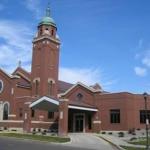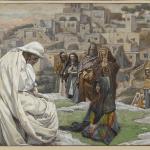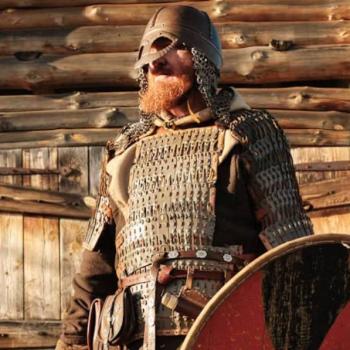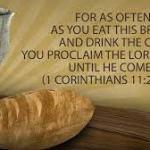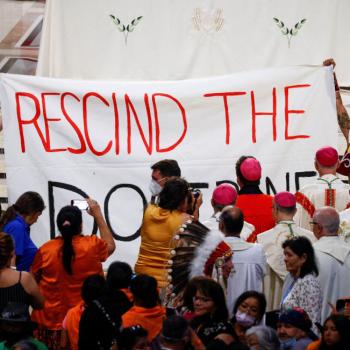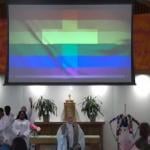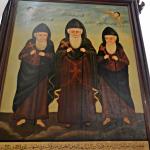And some thoughts for Eucharistic Revival
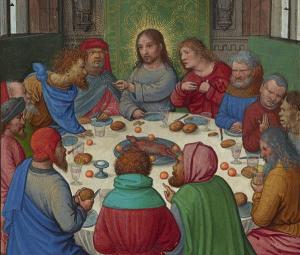
Two books by William R. Herzog II have been the subjects of several posts here. At the end of this study I am more convinced than ever of the importance of historical Jesus research. If God became incarnate in particular flesh at a particular time, then we should know about that history. Jesus’ death is a central event for Christians; therefore what Jesus did that led to his crucifixion must be near that center. And if the Resurrection shows God’s approval of Jesus’ life, then we should, as Herzog does, investigate the history of that life. But these reasons skip over Good Friday and its introduction, Holy Thursday, too quickly. Herzog’s two historical studies ignored Holy Thursday completely.
This is the eleventh and last post on Herzog’s Jesus, Justice and the Reign of God. Earlier posts in the series are:
- The Historical Jesus and the Transcendent God in the Work of William Herzog
- Context Group Continues the Long History of Witnessing to Jesus
- Jesus Heals a Paralytic and Opens a Temple-Free Zone of Grace
- The Temple, Jesus, and the Little Traditions of Village Life
- A Rich Man Follows All the Old Rules. Or Does He?
- The Tradition of the Elders or the Mercy of God
- Jesus Reinterprets the Sabbath and Subverts the Social Order
- Dangerous Thoughts: Three Parables in Dissembling Villager Speak
- Personal Morality: Jesus’ Village Politics Can’t be Without It
- Render to Caesar or not: The Speech of Oppressed People
Before this series I posted on Herzog’s earlier book The Pedagogy of the Oppressed. That series’ conclusion, with links to other posts in that series is here.
Pedagogy of the Oppressed – a question
In Pedagogy of the Oppressed Herzog listens to Jesus’ parables the way a first-century Palestinian peasant, handyman, or day laborer would. This tactic became possible near the end of the last century because of a growing body of research into ancient Mediterranean societies. Not only possible; I’d say it’s the correct way to discover what Jesus meant his parables to say. He knew his audience and how they would understand his words. What people would understand must be what he meant to say. The so-called “Markan secret” can’t mean that Jesus deliberately kept the truth from his favorite people, the crowds of poor that came to him.
But there was a kind of secrecy and hiding of the truth that Jesus practiced. It was the dissembling speech that oppressed people worldwide have learned to use in the presence of their oppressors. Jesus coded dangerous ideas into innocent-seeming tales and aphorisms. Two examples from Herzog show Jesus doing that:
- Seed Growing Quietly
Jesus told a simple story about seed growing – so simple that one would wonder why he told it or what to make of it. Pretty hard to make anything treasonable out of it, anyway. The seed just grows. The earth produces “of itself.” But religious powers have been telling peasants that the earth doesn’t produce “of itself.” It requires the blessing of the temple, which comes at the price of dues, tithes, and sacrificial animals. Jesus noticeably left that part out. The only blessing peasants’ crops need is the virtue that a generous God put into the soil to begin with. (See this post) A later generation, most likely not farmers, would make of this short story a metaphor for the quiet growth of the Church.
- The Laborers in the Vineyard
Jesus told a more complex story about a rich vineyard owner who sent laborers out into his fields. Though they went out at several different times of the day, he paid them all the same daily wage. Adding insult to injury, he had the first arrivals watch while he paid the late comers. Then he browbeat one of the first crew, all of whom complained that they should have gotten more. A later generation would see in the landowner’s action the freedom with which God bestows grace. Day laborers in Jesus’ audience would have seen not God’s dealings but their own oppression in the insulting behavior of this aristocrat. (See this post.)
With several more of Herzog’s readings of Jesus’ parables, one sees Jesus as calling for justice for the poor. Church doctrine doesn’t say Jesus was a social justice activist in a small land east of the Mediterranean Sea. Instead, Christians say Jesus reconciled a whole fallen world to God. He initiated a new covenant in his blood. He made actual in his body what the temple prefigured. With a sacred meal, first celebrated on Holy Thursday, he gave us a foretaste of the coming Kingdom of God. Does Herzog’s view of the historical Jesus leave out the most important part? Herzog’s later book, Jesus, Justice, and the Reign of God, intended to answer that suspicion.
Jesus, Justice, and the Reign of God – Herzog’s answer
In Jesus, Justice, and the Reign of God, Herzog sets out to answer criticisms of his earlier work. The former book showed Jesus in parables throwing light on and offering hope in Palestine’s “dark world of oppression.” (Jesus, Justice p. 47) The newer book focused on Jesus’ actions and controversies with authorities. It showed more clearly Jesus’ theological stance, his faithful understanding of the God of Jewish Scripture. Jesus calls Israel back to Yahweh’s justice.
This stand still meant attacking the social, political, and religious structures that weighed heavily against the poor. But Herzog now places this social activism clearly in the service of God, as the prophets and the Law demanded. That is the second book’s advance over the first. Jesus is not just “pedagogue of the oppressed” but also “prophet of the justice of the reign of God.” That prophetic work led to Jesus’ death, as advocacy for the poor makes martyrs today.
Herzog finds an irony in the official proceedings leading to Jesus’ execution, and the history is convincing. It seems that two of the charges brought against Jesus were correct, or close to the mark. Jesus cast doubt on the obligation to pay the Roman tax. And if he didn’t threaten to destroy the temple, much of his work and teaching was a direct threat to the temple’s current mode of existence. A third charge was not true, and that’s the charge on which Jesus was convicted in the end. Jesus did not claim to be king of the Judeans. (p. 245) Jesus’ work was not about owning the kingdoms of this world.
The risen Christ and the historical Jesus
Of the resurrection Herzog says it is God’s “validation of Jesus’ work and the confirmation of Jesus’ way.” (p. 250) If that’s true, then no spiritualizing of the resurrection will do. The resurrection didn’t happen only in the experience of the early Church or to the Church’s “Christ of faith.” It must have happened to the flesh and blood Jesus of history.
Herzog continues:
[B]ecause of that, the historical Jesus has no less relevance for the life of faith than the Risen Christ. (p. 250)
The resurrection validates the “prophet of the justice of the reign of God.” But I wonder. Perhaps it’s Herzog’s prior interest in getting history right that moves Herzog to see the resurrection this way. At any rate, what the resurrection validates could be more than a prophet of justice. Whatever that more is, it wouldn’t leave behind the prophet of and agitator for justice.
More than a prophet
From early on the Church has seen more than a prophet in Jesus. Herzog says Jesus “came to be seen as a figure who mediated God’s covenant love, God’s justice, and God’s healing power.” (253) That figure shows clearly in Herzog’s analysis of Jesus’ words and powerful signs in first-century Palestine. But does Jesus’ mediation continue beyond his short career in the flesh on earth? That, of course, is a basic theme of the Church’s developing Christology.
Jesus’ time on earth, Herzog says, became “the foundation for a fuller christological elaboration of Jesus as exclusive mediator of God’s beneficence.” (p. 253, my emphasis) We see that exclusive mediator, Herzog says, in the letters of 1 Timothy, and Hebrews. In Ephesians and Colossians there’s a universalization of Jesus’ particular acts of forgiveness of sin and debt. In a tendency to spiritualize, though, debt mostly falls out, except where its echo persists in the Lord’s Prayer. (p. 254)
More movements characterized the developing Church theology:
- The “something greater than the temple” became the Body of Christ and its extension in believers. (1 Corinthians 3:16-17 and John 2:21))
- “Jesus, the interpreter of God’s Word, became Jesus the embodiment of God’s Word.” (John 1:14)
- “The renewal of the covenant … became the new covenant found in Jesus.” (1 Corinthians 11:25)
- The reign of God became the final coming kingdom: “Thy kingdom come, thy will be done on earth as it is in heaven.” (Matthew 6:10)
I can almost see two laments in Herzog’s analysis: “None of these developments was necessarily misguided,” he says. But (one): “[T]he message of the justice of the reign of God was subordinated to other [more spiritual] concerns.” And (two): “[N]either were these developments conducive to the recovery of the historical Jesus.” (p.255)
Church theology and the historical Jesus
Among Bible scholars one easily finds agreement with Herzog’s first lament. There is a turn in New Testament writings from material to spiritual concerns, e.g., from debt to sins. But I question the second. Perhaps this developing Church theology isn’t so far from the mind of Jesus. Why wouldn’t an early Christian interpretation of Jesus’ work be something like Jesus’ own?
Church interpretation leaned on Jesus’ “work” on Good Friday more than on his advocacy for the oppressed poor. But Jesus also may have learned gradually to put his increasingly likely fate at the center of his thoughts. That would be, however, without forgetting the lot of the poor.
I’ll be looking for that thought of the poor as Jesus, on Holy Thursday, interprets his anticipated death. His “Last Supper” with his disciples, that Paschal, or Paschal-like, meal is strangely missing in both books of Herzog’s I’ve been studying.
With a great deal of skill, Jesus avoided the grasp of his opponents for most of the week that we call “Holy Week.” At the same time he was secretly getting things ready for his final meal. It must have been very important to him. Jesus’ words on Holy Thursday certainly were important – perhaps too important – to the Church’s theology of Eucharistic real presence.
What Jesus may have imagined on Holy Thursday
The Church has read “real presence” into Jesus’ words at Holy Thursday’s Last Supper. Paul wrote thus to the Corinthians:
For I received from the Lord what I also handed on to you, that the Lord Jesus on the night when he was betrayed took a loaf of bread, and when he had given thanks, he broke it and said, “This is my body that is for you. Do this in remembrance of me. In the same way he took the cup also, after supper, saying, “This cup is the new covenant in my blood. Do this, as often as you drink it, in remembrance of me.” For as often as you eat this bread and drink the cup, you proclaim the Lord’s death until he comes. (1 Corinthians 11:23-26)
The repeated phrase “This is….” seems clear enough to us from a distance. Did Jesus himself imagine something like his own real presence as bread and cup?
Perhaps not. Does the Church even need to rest its theology on these words of Jesus? The Church’s own experience, guided by the Spirit, is also a source of her theology? Think of John’s Gospel and its Eucharistic controversy. There John has Jesus in graphic terms insisting to a skeptical crowd that one must eat, even chew, his flesh. (John, Chapter 6) That was an example of Church theology developing.
I’m taking another look at Jesus’ words in the Passover celebration on Holy Thursday. When I look at the words and imagine the feeling underlying them, I find something besides real presence. It adds to, doesn’t detract from, what we’ve always believed about the Eucharist.
Another look at Holy Thursday
I’m going to take some words from a modern celebration of Passover, called the Haggadah, and insert them into the Last Supper. I’ll imagine a first-century Palestinian take on them. (From “English Haggadah Text with Instructional Guide,” online at Chabad.org):
This is the bread of affliction that our fathers ate in the land of Egypt.
And:
We were slaves to Pharaoh in Egypt, and the L-rd our G-d, took us out from there with a strong hand and with an outstretched arm. (Italics mine in both quotes)
Notice how similar to Jesus’ words are the words I put in italics: “This is” and “We were.” Would these words have spoken to Jesus and the apostles of their really being with slaves in Egypt? Or that the bread is really the same as what the “fathers” ate. I can only summon up the feelings these words might have conveyed. They would be feelings of identification with oppressed Hebrew slaves in a strange land. That was the point and, I imagine, the feeling of Passover. That and the obligations God imposed on a people rescued from slavery:
You shall not wrong or oppress a resident alien, for you were aliens in the land of Egypt. You shall not wrong any widow or orphan. (Exodus 22:20)
We can imagine the feelings. We can also pretty certainly not tell for sure what the substance of the Last Supper’s bread and cup would have been in Jesus’ or the apostles’ theological imaginations. Safest, I think, would be to stay with the feelings from the words — “This is my body … a new covenant … in my blood.” These words may have worked for Jesus and the Twelve much like the way the Haggadah’s — and the Jewish Scriptures’ — “This is the bread of affliction” and “We were slaves in Egypt” work. The traditional Passover meal always was bread for the afflicted. Now Jesus adds his own body to that metaphor. This body, through years (but maybe there was only one year) of public service, was metaphorical bread for the afflicted of Palestine.
A new covenant
That first Holy Thursday Jesus was turning toward his own affliction shortly to come. It couldn’t have felt like turning away from his work, up to then. He didn’t stop being “pedagogue of the poor” and “prophet of the justice of the reign of God.” The resonance of Passover and Yahweh’s preference for the poor would have been too strong for that. So would the memory, palpable around that Last Supper table, of all that Jesus previously had been up to and through.
Jesus’ storytelling and preaching, his healings and exorcisms stood in opposition to the reigning status quo and its political and religious powers. In all of these ways he stood with Palestine’s oppressed poor. That’s how he interpreted and lived out the covenant of the Jewish Scriptures. On every Passover Jesus recalled and celebrated that covenant, which he taught us to call “good news,” gospel. On Holy Thursday he brought that good news, into a new covenant, which would begin with his final act of obedience to God on Good Friday.
“This cup is the new covenant in my blood.”
“In my blood,” that is, at the cost of my life. Jesus wouldn’t, at this crucial moment, have forgotten his former opposition to self-serving political and religious powers or his advocacy for the poor. It’s for that activism that these powers, guarding their own interests, criminalized and executed him.
And Eucharistic Revival
The Church in America is far from the perilous situation of Jesus and his followers at that first Eucharist. But we are undertaking a Eucharistic Revival because of a peril of our own making. Apparently, a large percentage of U.S. Catholics no longer believe – or understand – what the Church says about the Eucharist. Jesus is really present, “body, mind, soul, and divinity,” under the forms of bread and wine. Naturally the revival will stress that doctrine. We will be told that Jesus didn’t say, “This represents, or symbolizes, my body … my blood” but “This IS….” As if that settles the matter.
I fear that what Catholics will get out of such teaching is a poor version of Church. That would be a version that depends too much on biblical literalism and too little on the Spirit’s guiding the Church in, for example, John’s Gospel. More, I fear that the “real presence” in the mind of the faithful will be philosophically sound, with the verbal gloss of “substance” and “accident” and “transubstantiation,” but fail to inspire or challenge. It may give us an intellectual or faith challenge: How can I believe that! Or it may give us necessary support: I have Jesus, really. But it could fall short of the real challenge – to take part as Christians today in the dynamism and danger of Jesus’ public career from beginning to end. That would be a sad reflection on Holy Thursday, the day when the threat hanging over Jesus was about to become real.
What Herzog accomplished: an evaluation
William Herzog shows us the danger that Jesus courted throughout his ministry. He places us with peasants, debt slaves, struggling artisans, and desperate day laborers. There we see Jesus challenging economics that transferred wealth from the poor to the rich. (Like today’s economy) He challenged purity laws and temple fees laying impossible burdens of the poor and justifying their low social status when they couldn’t comply. (Like blaming the poor for their poverty today) Jesus threatened political and religious powers. He was a genius at hiding the lower classes’ subversive thoughts in parables, and he excelled in confrontations with his opponents. Jesus engaged the pressing issues of his day. And he made enemies. (As Christians ought to do today)
This picture of Jesus Herzog finds in the literature that grew up among Jesus’ followers, especially the Gospels. But another picture, a more spiritual Jesus, develops at the same time and tends to take over.
If the Last Supper was a Paschal meal as well as the first Eucharist, then the picture Herzog developed remains true to Jesus through Holy Thursday and beyond. Jesus and the apostles at the Last Supper are, in some way, among the slaves in Egypt and the poor of all time. So are we at every Eucharist. The bread that Jesus called his body is also the bread of affliction, the food of slaves and the poor.
On Holy Thursday Jesus spoke of a new covenant in his blood, of remembrance of him, and “until he comes.” Holy Thursday transferred all that Jesus had been into a new key that Church theology developed. A positive development, this Catholic believes, but one that shorted or obscured some of what Jesus was, handing on to us a too-spiritual Jesus. Herzog and other Jesus historians restore important parts of the picture. They keep the historical Jesus, the subject of continuing in-depth historical inquiry, relevant to the Church’s belief and practice.


